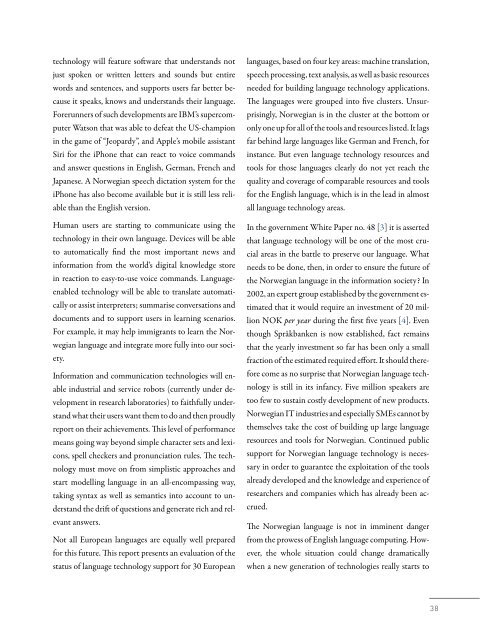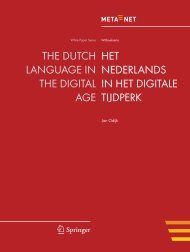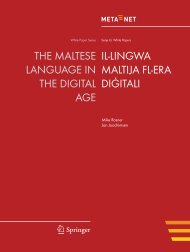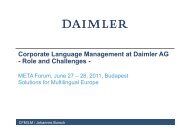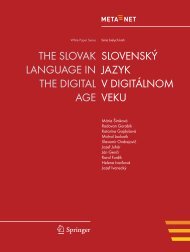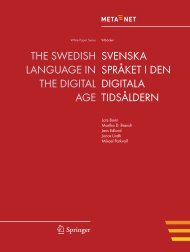Norsk i den digitale tidsalderen - Meta-Net
Norsk i den digitale tidsalderen - Meta-Net
Norsk i den digitale tidsalderen - Meta-Net
Create successful ePaper yourself
Turn your PDF publications into a flip-book with our unique Google optimized e-Paper software.
technology will feature soware that understands not<br />
just spoken or written letters and sounds but entire<br />
words and sentences, and supports users far better be-<br />
cause it speaks, knows and understands their language.<br />
Forerunners of such developments are IBM’s supercom-<br />
puter Watson that was able to defeat the US-champion<br />
in the game of “Jeopardy”, and Apple’s mobile assistant<br />
Siri for the iPhone that can react to voice commands<br />
and answer questions in English, German, French and<br />
Japanese. A Norwegian speech dictation system for the<br />
iPhone has also become available but it is still less reli-<br />
able than the English version.<br />
Human users are starting to communicate using the<br />
technology in their own language. Devices will be able<br />
to automatically find the most important news and<br />
information from the world’s digital knowledge store<br />
in reaction to easy-to-use voice commands. Language-<br />
enabled technology will be able to translate automati-<br />
cally or assist interpreters; summarise conversations and<br />
documents and to support users in learning scenarios.<br />
For example, it may help immigrants to learn the Nor-<br />
wegian language and integrate more fully into our soci-<br />
ety.<br />
Information and communication technologies will en-<br />
able industrial and service robots (currently under de-<br />
velopment in research laboratories) to faithfully under-<br />
stand what their users want them to do and then proudly<br />
report on their achievements. is level of performance<br />
means going way beyond simple character sets and lexi-<br />
cons, spell checkers and pronunciation rules. e tech-<br />
nology must move on from simplistic approaches and<br />
start modelling language in an all-encompassing way,<br />
taking syntax as well as semantics into account to un-<br />
derstand the dri of questions and generate rich and rel-<br />
evant answers.<br />
Not all European languages are equally well prepared<br />
for this future. is report presents an evaluation of the<br />
status of language technology support for 30 European<br />
languages, based on four key areas: machine translation,<br />
speech processing, text analysis, as well as basic resources<br />
needed for building language technology applications.<br />
e languages were grouped into five clusters. Unsur-<br />
prisingly, Norwegian is in the cluster at the bottom or<br />
only one up for all of the tools and resources listed. It lags<br />
far behind large languages like German and French, for<br />
instance. But even language technology resources and<br />
tools for those languages clearly do not yet reach the<br />
quality and coverage of comparable resources and tools<br />
for the English language, which is in the lead in almost<br />
all language technology areas.<br />
In the government White Paper no. 48 [3] it is asserted<br />
that language technology will be one of the most cru-<br />
cial areas in the battle to preserve our language. What<br />
needs to be done, then, in order to ensure the future of<br />
the Norwegian language in the information society? In<br />
2002, an expert group established by the government es-<br />
timated that it would require an investment of 20 mil-<br />
lion NOK per year during the first five years [4]. Even<br />
though Språkbanken is now established, fact remains<br />
that the yearly investment so far has been only a small<br />
fraction of the estimated required effort. It should there-<br />
fore come as no surprise that Norwegian language tech-<br />
nology is still in its infancy. Five million speakers are<br />
too few to sustain costly development of new products.<br />
Norwegian IT industries and especially SMEs cannot by<br />
themselves take the cost of building up large language<br />
resources and tools for Norwegian. Continued public<br />
support for Norwegian language technology is neces-<br />
sary in order to guarantee the exploitation of the tools<br />
already developed and the knowledge and experience of<br />
researchers and companies which has already been ac-<br />
crued.<br />
e Norwegian language is not in imminent danger<br />
from the prowess of English language computing. How-<br />
ever, the whole situation could change dramatically<br />
when a new generation of technologies really starts to<br />
38


